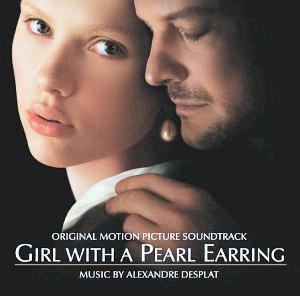************************************************************** EDITOR’s CHOICE February 2004 **************************************************************
Girl With a Pearl Earring
Music composed and conducted by Alexandre Desplat
James Boyd, viola and viola d'amore
Alexandre Desplat, flute
Frederic Gaillardet, piano
The Pro Arte Orchestra of London
Available On: DECCA 475 537-2
Running Time: 50.30
Crotchet Amazon UK Amazon US

See also: The Luzhin Defence
I was predisposed to like this score after being so impressed with Desplat's music for The Luzhin Defence (Film Music on the Web's 'Editor's Choice': November 2000). I was not disappointed.
The title track, which is slightly melancholic, sets a dreamy mood of yearning. Drops, splashes of colour from celesta and high treble piano suggest light flashing on pearl, while deep bass thuds suggest disturbance slightly apprehended. Only some slight material, enunciated on the viola d'amore, suggests in any way the period of Vermeer (1632-75); this is twenty-first century music.
The lovely lyrical wistful theme that begins to emerge in the opening track is beautifully developed on flute, and then in 'Griet's Theme' with celeste suggesting a glittering jewel. The waltz-like theme is gorgeously romantic; one senses a young girl's heart all-a-flutter with passionate anticipation. 'A New Life' continues the mood, develops Griet's theme but allows a note of anxiety and curiosity, while the trombone suggests a pomposity that might be encountered in 'The Master's House', a track which introduces darker, more turbulent material, anxious swirling strings and unsettling piano runs and questioning chords.
'Camera Obscura' conveys a sense of wonder through sustained high strings and further splashes of celeste and treble piano colouring. 'The Birth Feast' canters along in a frenzy of excitement, trumpet sounding joyful fanfares; yet there is tenderness too, that beguiles in a track which proves a little gem. 'Cornelia' pffers staccato piano hammering and disquietening, almost screeching strings, then 'Vermeer's Studio' returns to that sense of wonder first encountered in 'Camara Obscura' with Griet's theme stated not so romantically on viola d'amore in a piece which features some very imaginative writing.
'Winter Nights' is bliss in a snowy landscape, with Griet's theme in full romantic throat. There are interesting pizzicato effects over cantering staccato bass strings and long held and fluttering viola figures, together with an odd sourness in 'Van Ruijvan,' another extraordinarily imaginative track and one that is, perhaps, closer to a seventeenth century musical style. This style is maintained in 'Home', scored for just flute and viola d'amore.
'Colours in the Clouds' is another pensive, dreamy evocation of, one imagines, colours brightening as clouds lighten. 'The Master is Painting' is tender and tinged with magic with cymbals barely brushed. 'By the Canal with Pieter' waltzes and swirls by as in a bejewelled dream, and 'Catherina's Pearls' is bouncy with the excitement of inspiration.
Track 16 follows with a string only version of 'Colours in the Clouds', deepening the colourations. Another reprise follows this time of the title track followed by a piano solo, 'Silence and Light' that states and meditates on the main theme. After yet another reprise: 'Griet's Theme', the album concludes with 'Griet Remembers' in which cool, remote piano chords are most prominent.
I have set my thoughts straight down, spontaneously, as the music unfolded. I think you may sense my continuing delight and enthusiasm for this score. Such imagination and beauty deserves every recommendation.
Ian Lace
5
Gary Dalkin adds:
While finding this BAFTA nominated score a delightful listen on disc I can not be quiet so enthusiastic as Ian, if only because the music reminds me so much of a previous score. In fact that I can not help but wonder if this film about Vermeer was at one stage in its development temp-tracked with music from John Ottman's Incognito, a little known 1997 thriller about a modern day forger attempting to counterfeit a Rembrandt. Desplat's work is clearly his own, entirely different in terms of melody and orchestration, yet in places has an evocatively similar dream-like, romantic, erotic quality. (There is even a suggestion in the sensuous, endlessly entwining melodic writing of Pino Donaggio's Dressed to Kill (1980)). However, it is a case of like one, like the other; Ottman's much more suspense orientated score is my favourite of that composer's work, and the more I listen to Desplat's The Girl With A Earring the more I appreciate what is actually a finely crafted, very different and utterly absorbing work of film music art. The resultant CD is a splendid album which should appeal strongly to those who appreciate Jean-Claude Petit's wonderful music for Cyrano de Bergerac (1990), a reissued edition of which I also review this month. There can probably be no stronger recommendation than that.
Gary Dalkin
4 1/2
Return to Index